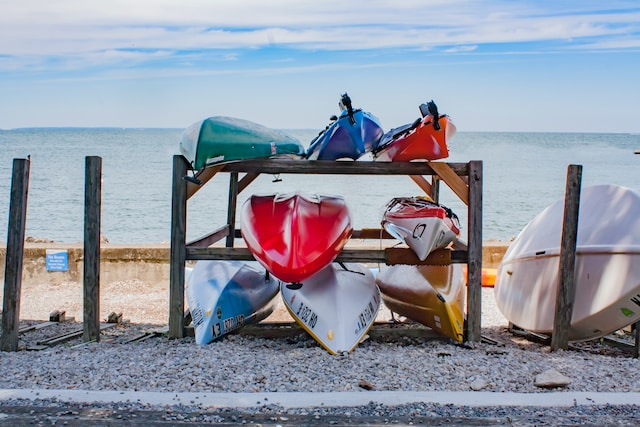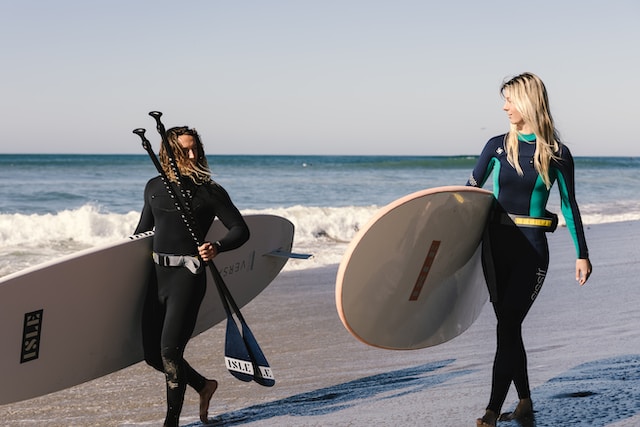Strictly speaking, “watercraft gear” applies to any vehicle that operates on or underwater, including boats, yachts, ships, submarines, and hovercraft. That said, we can nevertheless lump items like surfboards, stand-up paddle boards, or even seaplanes — while not considering them as boats or ships — into the category of watercraft gear. No matter what type of gear you’re talking about, they can result in a substantial investment of time and money. So, it stands to reason that safeguarding your investment would be a good idea.
The question then is: How do you go about safeguarding your investment? Read on to learn what you can do to ensure the safety of your watercraft gear, including how to choose storage and properly care for it.
Ensuring Longevity: Proper Watercraft Gear Storage
Power boats, fishing boats, sailing vessels, yachts, and ships are some of the most obvious types of watercraft gear, but other less obvious types fall under this heading.
Before we discuss how to safeguard your watercraft gear, it’s worth identifying some of them:
- Sailing boats
- Canoes
- Kayaks
- Personal watercraft/jet ski
- Rafts
- Surfboards
- Stand-up paddle boards
- Windsurfing boards
No matter what type of watercraft gear you have, whether large or small, you will need to store it at some point. Determining the best place to put your gear is up to you.
Choosing the right storage location
The most important part of safeguarding your watercraft gear is finding the right storage. Naturally, your storage needs will depend on exactly what you will be putting there, whether it’s a boat or a personal watercraft. You can store smaller items like surfboards, stand-up paddle boards, or windsurfing boards at home, provided you have enough space.
If you have a boat, however, you’ll need to consider a couple of factors when choosing where to store it:
- Weather control/element control. When you are not using your boat, you should ideally store it in a climate-controlled space with typical room temperatures and use a cradle to hold the boat, which will help prolong its life. UV rays, heat, and moisture can harm the materials your boat is made of — especially if it happens to be plastic.
- Holding cradle. Storing your boat on a cradle prevents the weight of the boat from causing the hull to warp if it’s lying on hard ground.
For personal watercraft, canoes, and kayaks, you have to meet the same basic needs, but you can store surfboards and such in the basement, garage, attic, or spare room as needed.
Cleaning and drying gear before storage

As with storage, cleaning and drying your water sports gear before you store it is important. Still, it varies according to the type of craft and the kind of water it’s typically operated in. Saltwater craft, for example, needs to have the salt washed off before storage so that it doesn’t cause rust.
On one end of the spectrum, you have to clean and store your surfboard:
- Thoroughly rinse the salt from your board using clean water.
- Remove the wax that is leftover from previous surfing sessions. You can do this by allowing the wax to soften for a little while under a warm sun, then scraping it off with an old credit card or a wax comb.
- Rinse the board again to make sure there is no wax left.
- Remove the fins. This saves storage space and prevents them from getting damaged.
- Put your board in a surf bag or surf sock to protect it from sunlight, dust, scratches, and dings while you’re storing it.
On the other end of the spectrum, you have to clean and store your boat:
- Thoroughly rinse your boat and clean it with marine cleaner and degreaser, including the areas that aren’t cleaned after each use.
- Polish all metal. An end-of-season polish helps prevent rust.
- Flush the tanks with clean, fresh water. Make sure the tanks are completely dry before you store the boat.
- Change the oil. Forgetting to change the oil each season can result in your engine exploding.
- Prime it. You don’t need to do this every season, but applying a coat of epoxy primer every few years will help protect your boat.
- Store the boat out of the elements, ideally in a climate-controlled storage facility.
- Store the boat on a cradle or some other apparatus that keeps it off the ground.
Utilizing storage racks and hooks

When it comes to storing smaller watercraft gear, storage racks, and hooks are wonderful things.
Storage racks come in a variety of types, including free-standing fixed structures, portable racks, wall-mounted racks, and even ceiling-mounted racks. These are excellent storage choices, but they tend to occupy a fair amount of space and can be expensive. There are also different types of storage racks for kayaks, canoes, and surfboards, so if you own multiple watercraft gear types, your storage racks could take up quite a lot of room. If you have that space to spare, racks are definitely a good choice for you.
If your space is at a premium, consider installing a series of hooks. You can mount hooks on the wall or the ceiling and use rope to ensure safekeeping. Hooks work well for kayaks, surfboards, windsurfing boards, and stand-up paddle boards, but you will need to anchor them securely if you intend to use them to store a canoe. Still, it’s not impossible, and storage hooks are a solid, space-saving option.
Avoiding direct sunlight and extreme temperatures
Sunlight and heat can degrade the materials your watercraft gear is made of, like plastic, fiberglass, nylon, the mono-film of a sail, and so on. UV rays can damage a boat’s gel coat (a layer of resin that acts as a protective skin), for instance, resulting in the breakdown of pigments and degradation of this layer over time. Since the purpose of a gel coat is to prevent moisture from entering the boat’s fiberglass, the gel coat must be protected.
Defending against wear and tear
The biggest part of safeguarding your watercraft gear is in maintaining it properly — after all, proper maintenance ensures that you will be able to enjoy it for longer.
Regular inspections and maintenance
All watercraft gear needs some level of cleaning after each use, in addition to periodic maintenance that you may need to perform. For example, surfboards need to be rinsed off after every session since salt can build up on the board and damage it. Boats out on the water need to be cleaned out and checked for damage before they get put away. It’s a good policy to set up a regular maintenance schedule so nothing falls by the wayside. This way, you can guarantee your boat’s oil will change or your surfboard will get cleaned as often as needed. Regular inspections are also a great way to see if any damaged or loose parts need to be replaced.
Properly storing life jackets and PFDs
As with the rest of your watercraft gear, properly storing your life jackets and PFDs is important to avoid damaging them.
Here’s how you do it:
- Make sure they are dry before being put away.
- Store life jackets flat or hang them on a wide hanger to avoid deforming the foam inserts.
- Keep them in a cool, dry place with good ventilation will prevent mildew growth.
- Store them away from direct sunlight since UV rays can compromise their buoyancy.
Lubricating moving parts
If your watercraft gear has moving parts, it’s a good idea to keep them properly lubricated to avoid them seizing up. Parts that are supposed to move but don’t can compromise the safe handling of the craft or safety gear. So, make sure to keep hinges, zippers, and so on lubricated, so they can perform their intended job.
Investing in gear covers and cases
Gear covers and cases run the gamut from boat covers to surf bags, with some kind of cover or case for virtually all types of recreational watercraft. These covers add an extra layer of protection, which is especially valuable if you can’t store your gear out of direct sunlight. Likewise, covers and cases shield your watercraft gear, preventing scratches or dings, making them an excellent choice for keeping your investment in good shape. In particular, the waterproof and UV-resistant covers used for outdoor storage and transport prevent the elements from damaging your gear.
Foiling potential thieves: securing your watercraft gear
Alongside the enjoyment you get from using your watercraft gear comes the potential for theft. After all, chances are pretty good your watercraft was not a cheap investment, so the potential resale value makes them attractive targets. Fortunately, as a watercraft gear owner, you are not without means.
Installing home security measures

Installing cameras, home alarm systems, motion sensor lights, or other security measures will deter potential thieves. You can choose a cheap system, but it does need to be reliable and effective. So, buying a set of fake cameras that only look like they are there to do a job will not cut it. Do yourself and your gear a favor by choosing a quality security system.
Using locks and security cables
Locks and security cables are very basic means of securing your watercraft gear, but they can be quite effective. Locking your gear to a fixed point (like a rack) and using specialized locks designed for watercraft use will go a long way.
Implementing alarm systems
There are a wide variety of alarm system types available, from alarms with built-in motion detection, vibration sensors, or simply door and window alarms. The latter type should do the trick if you store your gear inside. If you store your watercraft gear outdoors, however, you may need something that doesn’t depend on fixed entry points. This is where alarms with motion or vibration sensors will come in handy.
Safeguarding your investment: home insurance coverage for watercraft gear
Considering that your watercraft gear is part of your household and personal belongings, you may wonder if your homeowner’s insurance can cover them. Fortunately, they can be, but there are conditions.
Reviewing home insurance policies
Before you buy any watercraft gear, especially those representing larger investments, it may be wise to see if your home insurance will provide coverage for them in the event of a mishap. Take the opportunity to review your insurance to determine if your insurance policy covers your gear under its terms or if you need to set up additional coverage. Your homeowner’s insurance is able to cover the cost of replacing watercraft if someone steals them from your home or if hail damages them while they are in storage in an enclosed building, or if you lose any belongings you had on the craft.
For larger craft, purchasing separate insurance — in the form of boat insurance — may well be your best option. You may need to purchase a watercraft endorsement if you rely on your existing policy.
Supplementing coverage with endorsements or riders
It’s likely that, to cover your watercraft gear under the umbrella of your homeowner’s insurance, you will need to purchase a watercraft endorsement or rider. An endorsement, or rider, can cover the following: damage to your watercraft during boating excursions, boat replacement if yours sinks, damages that occur while you dock the boat, medical fees, or liability claims resulting from an accident.

Having watercraft gear sets you and your family up for a whole lot of fun, but it’s not without conditions. These conditions involve properly maintaining your gear, cleaning them, and ensuring you store them safely away from the elements. Putting additional security in place can also save you the heartache of someone stealing your watercraft gear. By following the tips and practices listed in this article, you can enjoy your investment for many years.




